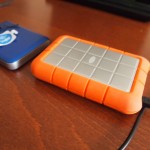Different orders coexist
Data laundry
An image in conversation
Imagine a picture
Viewed through the lens of an algorithm
The divisible present
Shared objects
The first object we encountered was a hard drive edged in elastic orange plastic, advertised to be able to survive drops of two meters, a claim we did not test. It had been prepared for us by prepared by Perttu Rastas of the Finnish National Gallery. While still in Helsinki, we begin our work by unpacking it.
While its contents are particular to Kurenniemi, the physical form and organization mirror a problem increasingly familiar to any personal digital archive; with snapshots of one device poured onto the next device with more storage space, the process repeated over time to form a tangle of nested digital histories, including duplications, empty folders, and a mix of unique self-made documents and backups of software programs and downloads. The disk contains a huge amount of photographs made during the whole of Erkki’s life with a variety of cameras and with a surprising intensity which inspired us to run our first experiment on the photographic material.
In addition to the digital files, the disk’s content includes digitized materials from various analog media (C-60 cassette tapes, Hi8 and DV tapes). Copying the files proved to be non trivial as differences in hard drive formats caused some strange behaviors when copying.
While there is no clear organization in the different elements rescued from backup drives and workstations of Erkki, it doesn’t mean no ordering was present. On the contrary, many orders coexist. The hierarchical folder organization of the file system, the documents in hypertext, groups of photographs selected to make a photo-CD, folders containing downloaded documents thematically arranged (‘Net Art’ contains reproductions of paintings downloaded from websites, ‘Old Porn’ contains reproductions of early 20th century erotic photographs, etc), photographs grouped by people, by travel destinations, collections of auto-portraits, etc. What those attempts at grouping, organizing have in common is that they are all abandoned for the next one and Erkki doesn’t look back. The material is therefore ordered in an ad hoc fashion; when a specific task requires it, but never in its globality. Erkki doesn’t believe in organizing schemes, taxonomies in the long run, or perha[s simply didn’t care.
The drive doesn’t contain only the collections made by Kurenniemi but also a series of collections that helped prepare the exhibitions of Kurenniemi’s work. The curated selections carefully isolate his experimental filmic production from the rest. And finally, we can find a series of files related to The Future Is Not What It Used To Be, a documentary made by Mika Taanila, as a portrait of Erkki.
Between the eclectic, incomplete and contradictory classifications of Erkki himself, the curatorial approach of the film critic or the biographical one of the documentary maker, we felt uncomfortable. We needed a more basic starting point but to be able to describe it we need now to make a detour.
